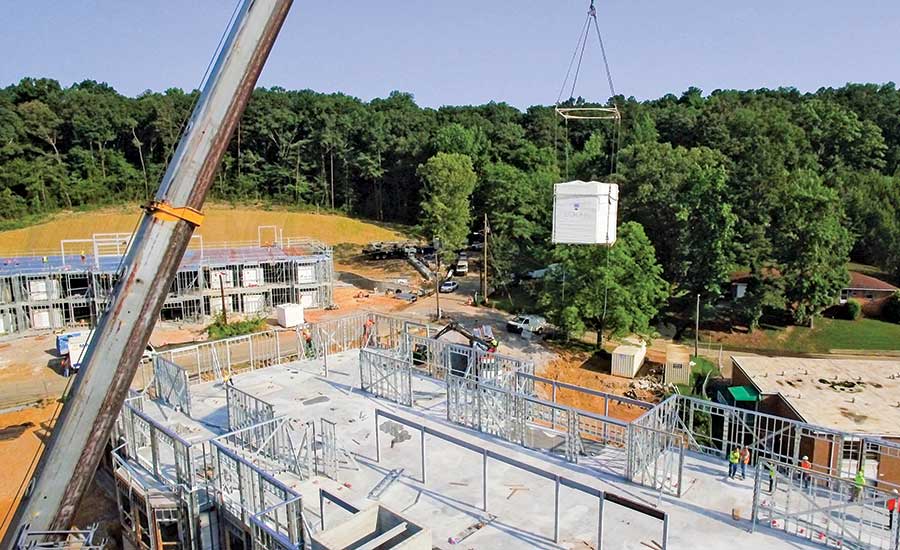Many of us have experienced that proverbial “lightbulb moment,” a flash of insight when the complexities of a new or challenging concept finally make sense. But when it comes to the nuances of prefabrication, a recent industry survey says many contractors are still in the dark.
For contractors that are applying prefab, that blindness can be particularly frustrating, given that the strategy of integrating pre-made components into the building process continues to make inroads in construction. Proponents say it improves efficiency, optimizes labor resources and lowers costs.
Clearly, prefabrication is on the rise. The average use of prefabricated assemblies in projects reached 35% in 2016, a threefold increase over the past six years, according to a new survey by Raleigh, N.C.-based management consultant FMI. Specialty contractors are leading the way, performing almost double the amount of prefab project work compared with GCs and GMs (44% vs. 23%).
Despite the growing use of prefabrication, however, FMI says only a handful (14%) of survey respondents believe their processes are living up to expectations. The rest consider them to be ineffective or in need of improvement.
FMI offers one explanation for these shortcomings, citing an individual firm’s level of understanding regarding what is essentially a manufacturing approach to construction, elements of which often vary from one project to the next. It amounts to an ongoing cycle of implementation, evaluation and refinement that influences every aspect of the process, from estimating and bidding to field operations.
In other words, prefabrication also requires a change in a contractor’s culture and operational philosophy, says Sabine Hoover, FMI content director and study co-author. As such, it demands a strategic approach that not all firms are willing to make. “Just dabbling in prefabrication is not the way,” Hoover says.
Firms that resist making a full commitment to prefabrication contribute to the disappointing results. Nearly 80% of FMI’s survey participants use prefabrication on less than 50% of their projects and are considerably less effective in its use compared with those that apply prefab processes on more than 50% of their projects.
What’s more, the manufacturing-based mind-set that is crucial to making prefabrication successful also requires time, patience and a willingness to accept that process refinements may sometimes result in failures and setbacks, a departure from construction’s traditional business strategy.
“Prefabrication is counter to every GC’s business model,” observes Geoff Golden, CEO of Golden Construction LLC, Birmingham, Ala. “If you’re not willing to try a new methodology and experiment with it, it won’t come to you.”
Constant curiosity is another key ingredient, says Steve Foote, vice president and operations manager for Greiner Electric, Denver. “The method you use may be cost-neutral, but there may well be a way that it could be better,” he says. “It’s staggering to think how long it takes to get good at it.”
All-in Adoption
Resistance to new ways of thinking is not limited to the construction industry, of course. But if a contractor’s leadership is unwilling to embrace prefab fully, it’s unlikely that field employees will. That lack of commitment can quickly undermine the cultural shift and the feedback loops that are key to making any new process work.
“If something doesn’t work, field employees need to feel safe about saying so,” Hoover says. “That’s different from the traditional work environment.”
Forcing prefabrication on field staff “will be a big mess,” agrees Foote. “They’ll hate it. But if they know they can really communicate with you, then they’ll help make the process work. It has to be implemented as a team.”
Aaron Thompson, vice president of design and fabrication for Corbins Electric, Phoenix, tackled this mind-set challenge by stressing to field staff that prefabrication is designed to eliminate work they didn’t want to do, not to eliminate their jobs. “It’s also important to get field-respected people in supervisory positions,” Thompson says. “That was a big step in gaining field buy-in.”
And like every other business practice, prefab processes demand constant, effective monitoring to gauge effectiveness, address deficiencies or problems and identify areas for improvement.
But as the FMI survey notes, many contractors don’t fully understand how to measure and track prefab efforts.
“It was hard to do in the early days,” admits Foote, adding that Greiner Electric now uses a proprietary system that determines the unit and time cost of every element in its prefab process. “That allows us to continually evaluate and improve,” he says.
“There’s a flow to manufacturing that you can see,” adds Golden. Training employees to observe the process and empowering them to interrupt things should quality issues arise can go a long way toward a goal that Golden characterizes as “smoothing the chaos of construction.”
But as Thompson has found, many GCs prefer the “chaos,” or at least the flexibility it affords to move trade workers to where they’re most needed on a jobsite as a project progresses. And that insistence on flexiblity can present another obstacle to the effectiveness of prefabrication, he says.
“Obviously, the more information we have about a project’s details and schedule, the better we can plan kit preparation,” he says. “GCs get nervous when they don’t see material sitting at the site, even if they won’t need it for a while. That’s changing as more GCs understand prefabrication.”
Initiating the Improvement Cycle
Right now, it is hardly surprising that contractors’ opinions and results are mixed, Hoover says. “We’re in a messy transition of baby boomers who want to hold on to old ways and new people coming in,” she says. “The better companies are luring younger workers who can deal with technology and understand change, and they’re the ones who will make prefabrication happen.”
Indeed, Hoover says prefabrication’s growth in construction may well be inevitable as its advantages continue to overshadow current work practices. “If you’re not willing to do things that will reduce schedule by 50%, reduce risk and improve safety, you’ll be out of it,” she adds.
Ultimately, what may attract more GCs and specialty contractors to understanding, adopting and improving their prefab mind-set is the same trend that affects other aspects of the industry—labor.
“There’s already a shortage of field guys now, and it’s only going to increase,” Foote says. “If you think there will be enough people to do work five years from now, you’re wrong. How will you be competitive if experience is at a premium and you have to pay higher rates?”
Fundamentally, adopting prefabrication comes down to attitude—that is, an open-minded, patient culture that is willing to learn and capitalize on what works and what doesn’t, Thompson observes.
“You have to be ready to take a punch in the face,” he says. “Just when you think you’re an expert, something happens.”





